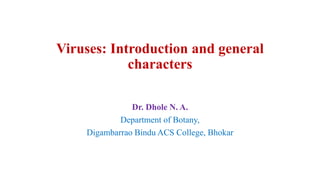
2. Viruses introduction and general characters
- 1. Viruses: Introduction and general characters Dr. Dhole N. A. Department of Botany, Digambarrao Bindu ACS College, Bhokar
- 2. Introduction: • The branch of science that deals with the study of viruses is called virology. • The scientists who work in this branch are called virologists. • Viruses are ultramicroscopic, acellular, infectious, nucleoproteinous, obligate parasites that can only replicate inside a host cell. • Viruses are much smaller than bacteria, their size is variable and which can cross the bacterial filter. • The extracellular forms of viruses are inert particles and are known as virions. • From a biological perspective, viruses cannot be classified either as living organism or non-living.
- 3. On the basis of the host cell they infect, • viruses infect to animals are called as zoophages (animal viruses), • phytophages (plant viruses), • phycophages (algal viruses), • mycophages (fungal viruses), • zymophages (yeast viruses), • bacteriophages (bacterial viruses), • cyanophages (infecting cyanobacteria), • coliphages (infecting E. coli bacteria).
- 4. • Viruses are visible only under the electron microscope . • The discovery of virus cannot be credited to any one scientist but it was the contribution of many scientists. • Louis Pastuer (1884): He coined the term ‘viruses’ (virus = poison) which are smaller than bacteria. He first demonstrated that viral diseases like rabies can be transmitted for one host to another. • Adolf Mayer (1886): He first discovered the mosaic disease of tobacco. • D.J. Iwanowsky (1892)- He first discovered the Tobacco Mosaic Virus causing mosaic disease of tobacco. • W.M. Stanley (1935): He first isolated and crystallized TMV. For this Stanley shared the 1946 Nobel Prize with Northrop and Sumner who had earlier crystallized the enzyme urease for the first time. Stanley is known as the ‘father of virology’.
- 5. General Characters of Viruses: • Viruses are non-living, non-cellular structure. • They do not have a cytoplasm or any kind of cellular organelles to carry out any kind of metabolism. • Viruses are able to infect all living forms including plants, animals, human beings and even micro-organism. • Viruses are obligate intracellular parasites they require a living cell or organism for its multiplication. • Viruses can be observed only under the electron microscope. • They are 10 to 100 times smaller than bacteria and its size ranges from 20 to 300 nm so these viruses can pass easily through bacteriological filters. They are filterable.
- 6. • Size of viruses is measure with the help Ultrafiltration, ultracentrifugation and electron microscopy. • Viruses do not have any kind of cellular organization. • Viruses have spikes which help the virus to attach on the host cell. • It contains either DNA or RNA as a nuclear material. • As we know viruses are an obligate intracellular parasite and lack the essential enzyme for protein and nucleic acid synthesis. These viruses depend on the host cell for its replication and multiplication. • Viruses are unaffected by antibiotics, there are many differences between micro-organism and viruses
- 7. • Viruses are of great concern in the field of medical microbiology because they are responsible for various human diseases. • Examples of diseases caused by viruses are Rabies, AIDS, Mumps, Hepatitis, Influenza, Dengue, common cold and many more diseases are caused due to viruses. • Viron is an extracellular infectious particle of the virus. • Viron contains essential nucleic acid which is protected by the protein coat called as the capsid. • The function of the capsid is to protect nucleic acid from nucleases and other environmental factors. • The capsid is made up of polypeptide molecules.
- 8. • Capsid shows two types of symmetry that are cubical or icosahedral symmetry and helical symmetry. • Icosahedral symmetry shows 12 vertices and 20 sides. • The icosahedral contains two types of capsomers Pentons at the vertices and hexons at the Facets or sides. • Different viruses have different shapes, most of the animal viruses are roughly spherical in shape, pox virus is brick shape, TMV is rod shape etc. • Viruses may be enveloped or non-enveloped. • Envelop is made up of lipoproteins and is derived from host cell membrane.
- 9. • Viruses require a living media like the embryonic egg, cell culture or bacterial cells. • Viruses are classified on the basis of morphology, chemical composition, and mode of replication.
- 10. References: • https://www.biologydiscussion.com/viruses/viruses-history-and- features-of-viruses/5675 • https://byjus.com/biology/virus/ • https://open.oregonstate.education/generalmicrobiology/chapter/int roduction-to-viruses/ • https://microbenotes.com/classification-of-virus/ • https://www.yourarticlelibrary.com/micro-biology/viruses-definition- characteristics-and-other-details-with-figure-micro-biology/26672
- 11. Thank you